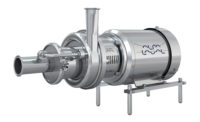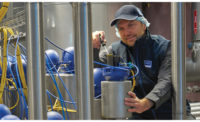Tracing and Tracking Aids in Food Safety
Imagine improving product safety, satisfying new tracking requirements, reducing waste and improving inventory management every time you move a pallet of products. That's what a well-planned bar code and radio frequency identification (RFID) data collection system can do.
Companies throughout the food industry supply chain must comply with a new FDA requirement created in December, 2004, and European Union traceability requirements that took effect in January. These require dairy and other food companies to keep product records at least one step back and one step forward in the supply chain.
When companies improve traceability, they improve their visibility into the supply chain, which can result in reduced buffer stocks, spoilage and stockouts. Food and beverage companies with best-in-class supply chain performance (defined as the top 20% in the industry) hold 60% less inventory than median performers, according to a study by Performance Measurement Group.
To gain these benefits, businesses need effective track-and-trace systems that identify the product, and they need to collect and share information efficiently. U.P.C. symbols and outer case codes pass the data-collection test, but do not provide enough specific data about the product in the container. An 8-ounce package of Kraft cheddar cheese packaged today will carry the same U.P.C. number as every 8-ounce package of Kraft cheddar cheese ever produced. More advanced bar code or RFID systems are needed to meet today's safety and regulatory requirements.
One option is to encode a unique serial number or lot code in an additional bar code. Aesthetics and space limitations make an additional bar code on product packaging undesirable, but the data could easily be formatted at the case or pallet level. Reduced Space Symbology (RSS) and two-dimensional (2-D) bar code formats enable variable information to be encoded in a small space. Manufacturers, logistics providers, distributors, retailers and institutions could record lot numbers as easily as scanning a bar code.
Warehouse management, inventory and other software applications could be modified so information captured by the bar code scan would link the products to specific orders or enterprises to help companies comply with traceability requirements. As more information is expressed in the label, new opportunities are created to leverage the information to create efficient new processes. For example, by being able to access expiration dates from a bar code scan, companies could better manage FIFO inventory management to reduce spoilage.
RFID allows for lot codes, serial numbers and other information to be captured automatically with no human intervention required to align or scan items. Readers can process multiple items simultaneously without double counting, which enables every tagged item on a pallet to be recorded in a single pass. Tiny tags can identify each item, with memory left over to encode lot codes, expiration dates, or production and handling records. RFID systems can also be integrated with temperature sensors to monitor storage conditions.
An FDA reporter concluded "Radio frequency identification (RFID) tagging of products appears to be the most promising approach to reliable product tracking and tracing" for the pharmaceutical industry.
Electronic Product Code (EPC) is emerging as the leading form of RFID used in the grocery, retail, pharmaceutical and consumer packaged goods industries. Major food retailers are systematically requiring their suppliers to apply EPC tags to cases, pallets and select items. The EPC system is especially effective for traceability because each EPC tag includes a serial number that uniquely identifies the pallet, case or item.
Good tracking is good business, and new requirements could serve as a catalyst for producers and distributors to develop efficient new business processes. Advanced bar code and RFID systems are the new tools the dairy industry can use to profit from new traceability rules.
Looking for a reprint of this article?
From high-res PDFs to custom plaques, order your copy today!




